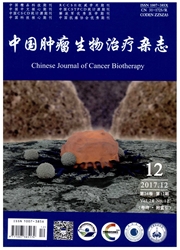

 中文摘要:
中文摘要:
目的:以改良方法在鸡胚绒膜尿囊膜(chickchorioallantoicmembrane,CAM)上接种人成神经胶质瘤U87细胞制备移植瘤,验证改良模型筛选抗肿瘤血管新生药物的有效性和可行性。方法:将鸡胚种蛋随机分为2组,分别使用传统方法与改良方法建立CAM-U87移植瘤模型;改良方法在鸡胚孵育中增加9—16h的开窗适应期,再将特制的硅胶圈放置在CAM组织-级血管的半侧;硅胶圈内接种U87细胞建立CAM—U87移植瘤模型。模型的硅胶圈内分别加入经典抗血管新生药物沙利度胺(50、100、200μg/ml)和自主研发抗血管新药G386,以DMSO为对照;体视显微镜观察肿瘤形态,H—E染色法观察瘤组织新生微血管密度(microvesseldensity,MVO),原位杂交(insituhybridization,ISH)技术检测血管标记物VEGFR2的表达。结果:成功制备改良CAM—U87细胞移植瘤,改良模型不影响CAM本身的血管生成,其瘤细胞接种成功率较传统模型显著升高[(70.00±4.226)%vs(41.25±5.154)%;t=4.314,P=0.0007],移植瘤体积显著增大[(60.20±6.012)vs(15.97±2.403)mm3;t=6.012,P〈0.0001]。沙利度胺和G386两药均能显著抑制移植瘤组织中的血管形成,使瘤组织中MVD显著降低[沙利度胺200μg/ml时(15.85±1.15)%vs(29.80±4.16)%;t=2.49,P=0.0474]、VEGFR2表达明显减少。结论:改良方法成功制备CAM—U87移植瘤模型,经沙利度胺和G386验证,该模型对抗肿瘤血管新生药物的筛选具有良好的有效性和可行性。
 英文摘要:
英文摘要:
Objective: To modify the classical chick embryo chorioallantoic membrane (CAM) xenograft model of tu- muorigenesis and evaluate the effectiveness and feasibility of the modified model in the screening of anti-angiogenesis drugs. Methods: Fertilized chicken eggs randomized into two groups. Eggs in the classical model group were grafted with U87 human glioma cells and the anti-angiogenic activity of test drugs, thalidomide (50, 100, 200 μg/ml), G3B6 and DMSO ( the control) was determined by following the well-established classical methods. In the modified model group, the CAM was given an additional adaptation period of 9-16 h and then grafted with U8 ceils by inoculating the cells into a sili- cone ring and then placing the ring on the half of the grade 1 vessel of the CAM. The test drugs were added into the sili- cone ring where their anti-angiogenic activity was evaluated. For both groups, the tumor morphology and the microvessel density (MVD) in the tumor tissue were examined under a stereo microscope with photos taken. Changes in the tumor his- tology was assessed by H-E staining and the expression of VEGFR2, the marker of the angiogenesis, was assessed by in si- tu hybridization. Results: The success rate of the xenograft was increased significantly without any negative effect on an- giogenesis in the CAM in the modified model as compared with the classical model ([70 ± 4. 226 ] % vs [41.25 ± 5. 154] % ; t = 4. 314, P = 0. 000 7). The tumor volume was also significantly increased in the modified model group ascompared with thecalissical model group ( [ 60.20 ± 6. 012 ] vs [ 15.97 ± 2. 403 ] mm3 ; t = 6.012, P 〈 0.000 1 ). Both thalidomide and G3B6 effectively inhibited the angiogenesis and reduced the MVD and VEGFR2 expression in the tumor tissue. Conclusion : The modified xenograft CAM model of tumuorigenesis developed in this study seems superior over the classical CAM model in studying tumorigenesis and screening anti-angiogenesis drugs.
 同期刊论文项目
同期刊论文项目
 同项目期刊论文
同项目期刊论文
 Andrographolide Suppress Tumor Growth by Inhibiting TLR4/NF-kappa B Signaling Activation in Insulino
Andrographolide Suppress Tumor Growth by Inhibiting TLR4/NF-kappa B Signaling Activation in Insulino Andrographolide inhibits melanoma tumor growth by inactivating the TLR4/NF-kappaB signaling pathway.
Andrographolide inhibits melanoma tumor growth by inactivating the TLR4/NF-kappaB signaling pathway. Slit2/Robo1 signaling promotes intestinal tumorigenesis through Src-mediated activation of the Wnt/b
Slit2/Robo1 signaling promotes intestinal tumorigenesis through Src-mediated activation of the Wnt/b (1)H NMR based serum metabolic profiles associated with pathological progression of pancreatic islet
(1)H NMR based serum metabolic profiles associated with pathological progression of pancreatic islet Inactivation of PI3K δ Induces Vascular Injury and Promotes Aneurysm Development by Upregulating the
Inactivation of PI3K δ Induces Vascular Injury and Promotes Aneurysm Development by Upregulating the Serum metabonomic analysis of apoE(-/-) mice reveals progression axes for atherosclerosis based on N
Serum metabonomic analysis of apoE(-/-) mice reveals progression axes for atherosclerosis based on N Deficiency of NOX1 or NOX4 Prevents Liver Inflammation and Fibrosis in Mice through Inhibition of He
Deficiency of NOX1 or NOX4 Prevents Liver Inflammation and Fibrosis in Mice through Inhibition of He Emodin attenuates high glucose-induced TGF-beta1 and fibronectin expression in mesangial cells throu
Emodin attenuates high glucose-induced TGF-beta1 and fibronectin expression in mesangial cells throu Berberine attenuates high glucose-induced proliferation and extracellular matrix accumulation in mes
Berberine attenuates high glucose-induced proliferation and extracellular matrix accumulation in mes 期刊信息
期刊信息
